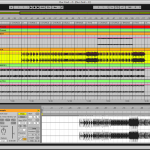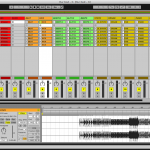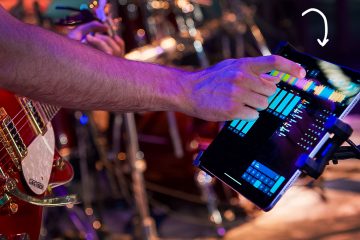Session View vs. Arrangement View


The big debate for using Loops and MultiTracks in worship – Session View or Arrangement View?
I hear this question a lot – in the forums, at conferences, in training sessions, twitter, blogs, grandma’s house, blah blah blah. It’s actually a really good question, and one that really confuses people who are just starting with using loops in worship and are Ableton live newbies. I’ll start off by saying that there are a lot of different opinions on this subject, as well as many pros and cons to using each view for the live worship setting. You can accomplish a lot with either view, which speaks a lot about the power and usefulness that Ableton Live brings to stage and studio performance. Both views are amazing and useful in what they are designed to do, but in this post we’ll look at using them in worship leading. First, let’s look at an overview of what these views are – then I’ll give my 2 cents. 🙂
OVERVIEW OF BOTH VIEWS
An Ableton Live Set consists of two views (Session and Arrangement View) which hold clips. Clips are the building blocks of Ableton Live. Arrangement View and Session View are connected to each other via Tracks. Here is how Ableton’s user manual describes each view:
ARRANGEMENT VIEW
A layout of clips along a musical timeline. The tracks are laid out horizontally from top to bottom.
SESSION VIEW
A real-time-oriented “launching base” for clips. Tracks are laid our vertically, from left to right. Every Session clip has its own play button that allows launching the clip at any time and in any order. Each clip’s behavior upon launch can be precisely specified through a number of settings.
I created a chart looking at the two views for use in worship leading:
SESSION VIEW |
ARRANGEMENT VIEW |
|
| PROS |
|
|
| CONS |
|
|
After making this chart, I realize even more so how great each view is and how they each serve a different purpose. Ableton is a great platform for creating music, and they made each view to help in that process. You can do so much in either view… And what’s better is that you can use these views together. For example, if you make loops in session view and come up with something really creative, you can record your song arrangement and flow into Arrangement view by hitting the Global Record button. As you play, everything you do (your performance) in Session View will be logged (recorded) into Arrangement View for further editing. I like to look at Arrangement View as the view where you “commit” to an arrangement of a song, edit the song structure and actually do a lot of audio editing for later playback. I like to look at Session View as the view where you create music live, play music live and record . In other words, use Session view to playback live what you previously committed to in Arrangement view.
WHAT I THINK IS BEST
What do I think is best for running loops in worship? Session View. Hands down.
Here are a few major reasons.
- I don’t have to create my set every single week. In Session view, I have one Master Song Set. I load all of my worship loops into this set, 1 song per scene (or 1 song section per scene). Then all I do each weekend is re-assign my foot controller to launch what songs I’m playing that weekend. If I were to use Arrangement view, I would have to drag and drop each song I’m playing that weekend, Add Locators, Assign MIDI to those locators, add tempo and time signature automation… A LOT OF WORK that doesn’t need to be done more than once.
- Easily Launch Individual Loops, Beats and Shakers. In Session view, I can load all sorts of beats, percussion, electronic elements and even band cues that I’m able to launch with my foot controller on the fly. Can’t do that in Arrangement view.
- Fader and Mixer controls are much easier to adjust. Personal preference…the vertical mixer view in Session View is much easier to adjust mixer parameters.
- Easier to see your entire setlist. The horizontal view in Arrangement view makes it harder to see your entire worship set. In Session view, all of the scenes are stacked, which lets you see the different sections of the song and what audio clips are playing in those sections.
- Flexible. Flexible. Flexible. When on the go, last minute in rehearsal or live in worship – you’re able to rearrange the setlist, change tempos, change arrangement quickly and easily. More below.
“The big advantage of Session view is it’s flexibility. When working in Arrangement view you are locked into a specific… arrangement. You are also pretty much locked into a pre determined set list as well. Let me explain with a few examples.I can create a set list with full backing tracks within session view in about 10 seconds. (Drag and drop from the browser.) If I want to later rearrange my set list it takes another 5 seconds. I can start a song with just click playing and wait for however long the teaching chorus or worship leader wants before launching the tracks. If I want to redo the chorus at the end of a song on the fly its only 1 button or trigger away. Creating tempo changes between songs also only takes 3 seconds instead of drawing in automation.
Both views can work… it’s just a matter of how much time you want to spend creating your sets and how flexible you want to be while playing.”
SO HOW DO I USE EACH VIEW?
- I use Arrangement View when I’m home recording music, building loops and editing audio.
- I use Session View when I’m on stage leading worship – launching loops, audio clips, and other effects spontaneously during worship.
Hope this helps as you’re deciding how to use each view. The Ableton Session products on Loop Community come in both Session View AND Arrangement view – why? Because we love you and know everyone uses Ableton differently – however, we strongly believe that Session View is the way to go. I want to hear your thoughts – comment below!
About the Author
Matt McCoy is a worship leader and songwriter from Chicago, IL. He has served on staff at Willow Creek Community Church and Harvest Bible Chapel, and is also a founder of LoopCommunity.com. He is an Ableton Certified Trainer and travels the country leading worship and teaching churches and musicians about using technology in worship. He has been using loops in worship for over 9 years. If you’re interested in training, contact Matt here.




